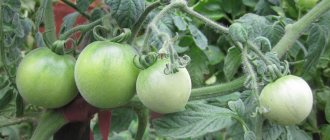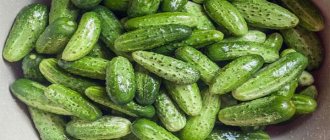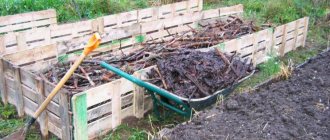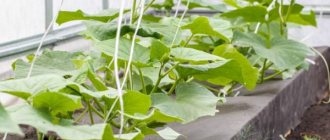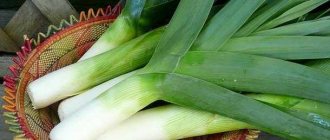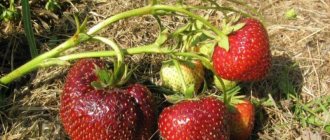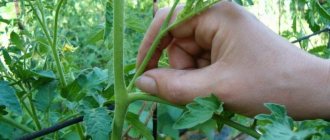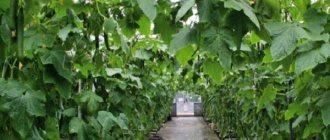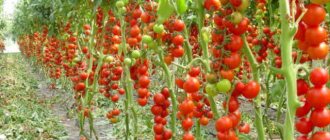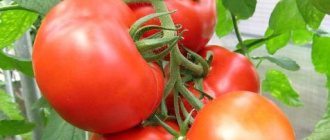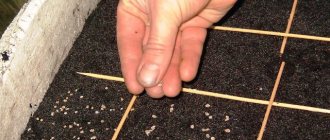The French call the tomato the apple of love, perhaps this is what inspired the breeders to create this miracle tree. In terms of external characteristics and size, a bush of such tomatoes is in no way inferior to an apple tree. Genetically, the “octopus” hybrid has the ability for intensive growth, and the height of individual representatives exceeds 5 m. For many gardeners, the tomato tree is something of a fairy tale; most simply have no idea that such a plant really exists. However, such a variety exists, although it was developed relatively recently. His productivity is amazing. Only it requires appropriate care. Let's try to figure out what kind of vegetable this is and how to grow it.
Description and characteristics of an unusual tomato
Based on the natural form, several hybrids have been created that take root in open ground, in a greenhouse, in a tub, and delight owners with juicy fruits almost all year round. This cute tree attracts visitors with its beautiful large leaves, which are heart-shaped at the base and pointed at the end.
Small flowers consist of 5 petals of lilac or light pink color. Fluffy stamens of a rich yellow hue rise above them. The leaves of the tomato tree resemble eggplants, and its trusses are the same as those of ordinary tomatoes.
The plant blooms like a potato. The trunk becomes woody over time. The fruits of tamarillo, or cyphomandra, appear in the second year, and the plant lives for 10–15. The berries, attached to the cluster with long stalks, turn yellow, bright red, purple, orange and even violet when ripe.
Attention! The shiny skin is hard and bitter and not suitable for consumption.
The sweet or sour juicy pulp surprises with the flavor of strawberries, apricots, and passion fruits. The berry weighs up to 150 g, and individual specimens reach 80 mm in length. One cluster bears 5–7 fruits. During their ripening period, the plant looks elegant.
What to do with seedlings?
ATTENTION: You should not conduct any experiments with this tomato variety, but grow only purchased seed material.
Agricultural technology is quite simple:
- The hybrid variety is disinfected and soaked in the traditional way for all tomato crops;
- Seedlings are planted in late January - mid-February;
- The optimal temperature for seedling germination is from +20 to +25 ºС;
- Seedlings need additional lighting and heating;
- Dive seedlings into spacious containers;
- Transplantation into open ground is carried out in May - mid-June (when 5-7 leaves appear and when they reach 30 cm).
REFERENCE: In regions with a warm climate, it is allowed to plant seeds directly in open ground.
The main advantages and disadvantages of the tomato tree
Cyphomandra has branched roots, but woody tomato takes root even in a pot and tub. Berries are collected in a heated greenhouse for more than six months. The benefits of growing a tomato tree include:
- High yield.
- Resistance to viruses and fungal infections.
- Long-term fruiting.
Important! Woody tomato can withstand temperature fluctuations and feels normal both with a lack and with an excess of moisture.
Red and purple berries are canned and squeezed into juice. Desserts are made from yellow and orange fruits, compotes, jellies, and jams are prepared. The aromatic dietary product is rich in:
- iron;
- pyridoxine;
- ascorbic acid;
- potassium;
- retinoids.
The tomato tree also has disadvantages. In the first year, the plant gains strength to bear fruit in the next season. Cyphomandra requires constant application of large amounts of fertilizer and does not develop at low temperatures. To reap high yields, the tomato tree needs to be planted in a spacious greenhouse. It is good to squeeze juice out of large fruits, but they cannot be preserved entirely.
Harvesting octopus tomatoes
When the tomatoes begin to turn red, begin harvesting. They do this until the fall.
After harvesting, the fruits are placed on the windowsill where they ripen. Leave them for about 10-14 days.
Particularly difficult care and special conditions for growing a tomato tree are not required.
It is important to remember that in open ground the hybrid will look more like a large and powerful tall bush.
When grown in a greenhouse, the tree grows to impressive sizes. Its height is practically unlimited, its width reaches several meters.
However, even in open ground the hybrid produces a rich harvest.
How to grow the best varieties of broccoli cabbage in open ground?
How to grow lush chard in open ground - detailed tips
How to choose and grow varieties of green beans for open ground?
- Author: Maria Sukhorukikh
Rate this article:
- 5
- 4
- 3
- 2
- 1
(0 votes, average: 0 out of 5)
Share with your friends!
What do you need for growing?
Summer residents who love to experiment, having learned about the unusual tomato, are interested in whether the tropical shrub really takes root in a temperate climate. A tomato tree is grown in seedlings, which means you need to purchase seeds. To collect more fruits, it is recommended to buy seed of tall varieties.
To grow in temperate climates, you will need a greenhouse. You need to stock up on compost and fertilizers in advance. To ventilate the roots, you need an air pump and a hose with holes.
Expert opinion
Stanislav Pavlovich
Gardener with 17 years of experience and our expert
Ask a Question
To plant tomato bushes, you need to prepare metal barrels, cut out the bottom, and make side holes through which oxygen can penetrate into the soil.
Possible problems during cultivation
As we have already noted, only the method of growing hydroponically practically eliminates problems such as rotting, viral and fungal diseases and the appearance of pests.
Unfortunately, when growing a tomato tree in the ground, the above problems may appear if the plants are not cared for properly and preventive measures are not taken.
Tomato bushes can rot in wet weather or with excessive watering over the entire surface of the bush, so water the tomatoes directly at the root, evenly and regularly.
Pests can also cause damage to this tomato variety. The most common are caterpillars and aphids.
Learn more about how to get rid of caterpillars and aphids on tomatoes.
It is best to spray with aqueous solutions of insecticides as a preventive measure or at the first sign of the appearance of harmful insects.
If you are a supporter of natural methods, then you can fight caterpillars by simply planting dill next to the tomato tree, and aphids are afraid of cold water and a mixture of soapy water and cayenne pepper.
Among the diseases, we note late blight, to which almost all varieties of tomatoes are susceptible. This fungal disease causes brown spots to appear on fruits, leaves and stems. Tomatoes are especially susceptible to this disease when there is a lack of sunlight and heat.
It is easier to prevent this disease than to fight it. Therefore, carry out prevention, for which you can use both natural remedies (saline solution, kefir) and special ready-made preparations (“Fitosporin”, “Shine”).
Varieties of tomato trees
The first giant grown from a tamarillo seed was presented by Japanese breeders at an international exhibition of technological achievements in 1985. The miracle tree f1 occupied a significant area of the pavilion. About 13 thousand red sweet fruits began and ripened on the powerful branches of the tomato.
See also General characteristics and nuances of growing tomato Polfast F1
An indeterminate hybrid produces many shoots that cannot be pinched. Brushes are laid over every 4th sheet. A Japanese tree can grow up to 4 meters in height, but to collect the same yields from a bush as at the exhibition, you will need a greenhouse heated all year round, hydroponics, a lot of time, and high costs for fertilizers.
Expert opinion
Stanislav Pavlovich
Gardener with 17 years of experience and our expert
Ask a Question
When grown under normal conditions, 1.5 or 2 buckets of tomatoes are picked from the Sprut hybrid, which are placed on clusters of 5 or 6 fruits; when ripe, they generally weigh 160 g.
The Inka Gold variety, like the Japanese tree, is characterized by unlimited growth and high yield. Ripe tomato fruits are yellow in color and have a surprising apricot flavor.
Sweet tomatoes of the Rotamer variety are not pickled, but are used to make jelly, marmalade and compotes.
Expert opinion
Stanislav Pavlovich
Gardener with 17 years of experience and our expert
Ask a Question
The fruits of the Solid Gold tree tomato have an attractive oblong shape, but not everyone likes their specific taste.
The ItalianTree variety is planted in European countries; in Russia it is mainly cultivated in a greenhouse. The Italian tree forms powerful branches on which the fruits are laid in clusters. Ripe tomatoes are covered with glossy pink skin; individual specimens weigh more than a quarter of a kilogram. The dense pulp has a pleasant sweetish taste and contains a lot of juice.
Tomato tree
Description of the hybrid:
- It is a perennial (up to 15 years) plant, of indeterminate type;
- The main stem does not stop growing and forms a large number of clusters;
- Reaches a height of 5 meters, crown diameter 50 m2;
- Each cluster ripens 5-6 fruits, with an average weight of 150 grams;
- The leaves are oval in shape;
- The flowers are white and pink;
- The shape of the fruit is elongated;
- Red, yellow, orange peel;
- Juicy aromatic pulp has a sweetish taste.
Application of tomatoes:
- Great for preparing vegetable cocktails, sauces, juices and various dressings;
- The fruits can be canned and stored for a long time.
Ordinary gardeners do not have greenhouses of the required size to grow real trees. For most gardeners, the best option is to grow Octopus in one season in a simple greenhouse or in open ground. To obtain a decent harvest, technologies for using effective biofertilizers will come to the rescue.
Cultivation technology
When cultivating a tomato tree in the usual way, and not using EM technology, summer residents manage to collect good harvests in a heated greenhouse and in a garden bed, of course, not a ton per bush, but 10 kg is realistic.
In the southern regions, where the climate is mild and there is enough moisture, cyphomandra seedlings are placed in a barrel filled with soil, compost and substrate, a standard tree is formed, which, growing, occupies a large area, and several hundred fruits are planted on powerful branches.
Preparation of soil and planting material
The seeds of the plant are dipped in water and left to soak for 12 hours, disinfected for 20–30 minutes in a solution of potassium permanganate, and heated in the oven. Immediately before planting, the seed of the tomato tree is placed in a growth stimulator - “Fitosporin”. The substrate is prepared by combining the same amount of:
- garden soil;
- coarse sand;
- peat
Expanded clay is poured onto the bottom of the container to prevent moisture stagnation. The soil is disinfected with potassium permanganate and an antifungal fungicide, watered with a composition for the preparation of which 2 tsp is dissolved in a bucket of water. urea and 1.5 tablespoons of superphosphate.
Expert opinion
Stanislav Pavlovich
Gardener with 17 years of experience and our expert
Ask a Question
Interesting! An exotic crop is grown in a barrel or bathtub without a bottom.
Planting seeds for seedlings
Tomato tree grains are placed in holes to a depth of 10 mm and covered with soil on top. The interval between the furrows is left at 5 cm. The soil is moistened with a spray bottle. To make the tomato tree comfortable, wrap the container with film. The box in which the holes are made is placed in a room where the temperature is not lower than 20 °C. Since the seeds of an exotic tree are recommended to be sown in January or February, special lamps are turned on for illumination. If you monitor the soil moisture and do not allow it to dry out, seedlings will appear in 2–3 weeks.
Selection and preparation of a place for transplantation
In nature, the tomato tree grows in sunny areas. In the shade, exotic bushes will not bear fruit. The barrel for planting the tsifomandra should be placed in the brightest place in the greenhouse, given that the branches grow greatly.
Transplanting seedlings into open ground
At least 10 cm thick urgasa is poured onto the bottom of the barrel, which is prepared in advance from food waste; special EM compost and soil are placed on top. The strongest bushes are planted in open ground. The hole in the container is made the same depth as in the box where the seedlings grew. A support is hammered in nearby so that the branches do not break under the weight of the fruit. The barrel is covered with polyethylene. When the tomato tree takes root and grows 10–15 cm in height, tear off the lower leaves and add substrate.
See also Characteristics, description and nuances of growing tomatoes Variety Rocket
Planting and watering
Scientists consider August to be the best time to plant seeds. This month, you should make cubes from glass wool with an edge length of 20 centimeters and a hole in the middle for seeds, treat them with a nutrient liquid and place them in a container. It is advisable to put a foam cover on top so that the solution does not dry out.
In summer, the temperature of the nutrient solution should not exceed 25 degrees, and in winter it should fall below 18 degrees.
Every two days the surface of the workpiece is moistened. Two months after seed germination, the small cube is replaced with a larger one, equipped with air ducts and immersed in a container.
Artificial lighting should function so that the plant is illuminated for at least 12 hours a day. In this case, you can count on the appearance of a large number of peduncles.
The tomato tree loves plenty of watering.
Some of the flower shoots need to be removed to form a nice thick crown.
The first eight months from the moment the first sprout appears, the tomato tree does not bear fruit, so the first harvest can be harvested around May.
If all agrotechnical recommendations are strictly followed, the tomato tree will grow at a rapid pace, so you should take care of installing a trellis at least two meters high. You can stretch the mesh and attach plant branches to it.
Rules for caring for a tomato tree
To obtain a fruit harvest, it is not enough just to create optimal conditions, but it is also necessary to comply with the requirements of agricultural technology.
Working with soil
After a week, when the seedling has taken root, soil is added so that the substrate reaches the top of the tub or barrel. The developed roots of a tomato tree require a lot of oxygen; regular loosening of the soil helps ensure its supply.
Fertilizer application and watering rules
Tomato trees need to be irrigated more often than conventional varieties. One bush requires at least a bucket of water 4-5 times a week. In hot weather, it is recommended to moisten the tomato tree every day, but the first watering after planting the seedling is done 14 days later.
First, the digitalis is saturated with minerals and vitamins contained in the substrate. In the summer, the growing tomato tree begins to lack nutritional components, and it is fed:
- superphosphate;
- manure;
- ammonium nitrate.
Attention! Fertilizer should be applied at least once every 3 weeks. When the stems become thin and brown spots appear on green fruits, mineral complexes containing boron are used.
Stepsoning
The lower shoots on the tomato tree are cut off when it takes root after planting, which is usually observed after a week. Having completed the procedure, add soil and urgas. After 7–8 days, the stepsons are removed again.
To speed up fruiting, the tomato tree is treated with a special compound. To prepare it, pine branches are frozen. After 2 weeks, boil in boiling water for about half an hour. Water is mixed with the solution in a ratio of 3 to 1, and the tree is sprayed during the formation of buds.
Preparing biocompost
You can use purchased biocompost, but it is advisable to prepare the soil mixture at home. Technology for self-preparation of soil mixture:
- You will need a bucket or similar container, at the bottom of which you need to attach a grate at a short distance;
- Line the walls of the container with polyethylene bags, with pre-drilled holes at the bottom;
- Place all food waste in the prepared bucket;
- For 10 kg you will need one kilogram of earth and sawdust;
- Stir until the soil mixture acquires a uniform, loose consistency;
- Spray the resulting composition layer by layer with the preparation “Baikal EM 1”. To prepare the solution, you need to dissolve 100 ml of the drug in a bucket of water and add liquid sweet jam without berries. Accumulate in large bags with a load on top;
- Control the humidity of the soil mixture within 50-60%;
- The mixture will take about two weeks to mature;
- Afterwards the mixture is dried.
Sprut variety tomatoes, care and cultivation:
Diseases and pests
The plant rarely suffers from late blight and mosaic, but is affected by septoria and gray rot. To prevent fungal infection, once a season the tomato tree is sprayed with the drug “Fitosporin”. If there is insufficient ventilation of the roots, the plant is attacked by parasites and harmful microorganisms. Treatment with iodine solution helps prevent the development of diseases.
To cope with the invasion of aphids, which love to feast on the juice, the tree is sprayed with wormwood infusion and sprinkled with tobacco dust.
Care every day
Throughout the growing season, it is necessary to carry out the following activities:
- Plant tomatoes until the barrel is completely filled with soil mixture. Subsequently, pinching of stepsons and buds is not used;
- In mid-summer, lashes and brushes are tied;
- Monitor soil moisture at 60%;
- Watering is carried out two to three times a week. Warm water is used for irrigation;
- Feeding begins in July. Two to three times a week with biocompost mash. Preparation of mash: fill the container 1/3 with mixed soil and biocompost in equal proportions. Fill with settled water to the top. Leave for 24 hours;
- Fertilizing with mineral or organic fertilizers should be carried out together with watering;
- As soon as the fruits of the first cluster ripen, you need to remove the leaves. Repeat the procedure as soon as the fruits on the second cluster begin to turn brown;
- Throughout the growing season, it is necessary to remove old, wilted leaves that are beginning to turn yellow;
- For preventive purposes, water with a weak aqueous solution of iodine.
Choosing a place
The tomato tree grows well in open ground, but it is preferable to use barrels or boxes for growing:
- You need to take a barrel whose volume is at least 200 liters. A wooden box or a thick polyethylene bag is also suitable. To remove excess water, you need to knock out the bottom of the barrel;
- Using a 20x20 pattern, make 1 cm holes in the walls. They will provide air access to the roots. Place the barrel on a sufficiently illuminated side;
- Pour the mixture in equal proportions in layers of 10 cm: soil, turf and biofertilizers;
- Make a small hill by filling a bucket of fertile soil;
REFERENCE: Before filling the barrel with soil mixture, you need to place a rubber hose in it, in which several slits are made. Close the end of the hose that is at the bottom tightly. Connect the pump externally. Blow air twice a week to improve ventilation.
- It is necessary to plant the strongest seedling, first tear off the lower leaves and stepsons;
- Cover the top with a 10 cm layer of soil mixture;
- Cover with film until frost stops;
- As soon as the shoots grow 10 cm, sprinkle with soil up to the lower leaves. The procedure is repeated until the landing tank is completely filled.
